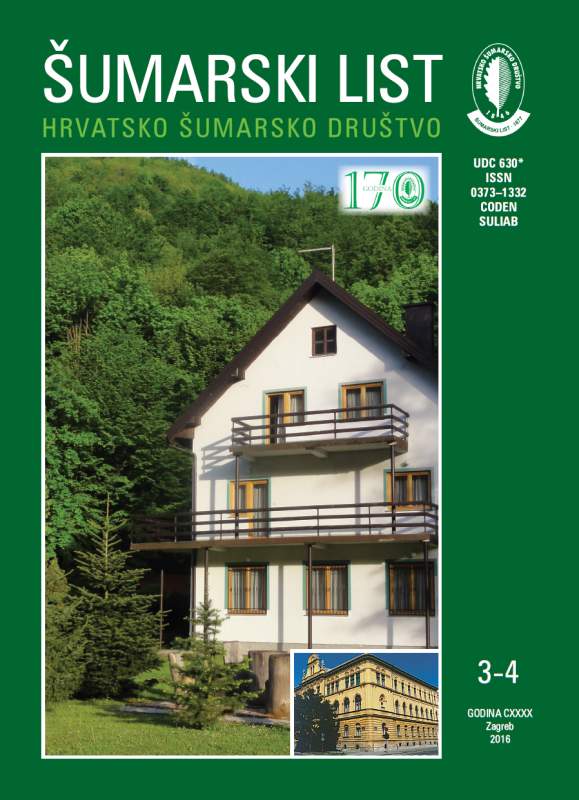
broj: 3-4/2016
pdf (14,09 MB) |
|
||||||||||||||
| RIJEČ UREDNIŠTVA | ||
| Uredništvo | ||
| IT IS TIME TO FINALLY FORMULATE A CONSISTENT FORESTRY POLICY AND FORESTRY STRATEGY pdf HR EN | 109 | |
| IZVORNI ZNANSTVENI ČLANCI | ||
| Jozo FRANJIĆ, Gabrijel HORVAT, Daniel KRSTONOŠIĆ | UDK 630* 111 + 113 (001) | |
| NEW LOCALITIES AND SYNTAXONOMIC CHARACTERISTICS OF SEA BUCKTHORN (Hippophaë rhamnoides L., Elaeagnaceae) IN CROATIA pdf HR EN | 111 | |
| Ivan ANDRIĆ, Igor POLJAK, Marno MILOTIĆ, Marilena IDŽOJTIĆ, Davorin KAJBA | UDK 630* 165 + 111 (Fraxinus angustifolia Vahl) (001) | |
| LEAF PHENOLOGY CHARACTERISTICS OF NARROW-LEAVED ASH (Fraxinus angustifolia Vahl) IN CLONAL SEED ORCHARD pdf HR EN | 117 | |
| Dalibor BALLIAN | UDK 630* 443 (001) | |
| GENETIC STRUCTURE OF SESSILE OAK (Quercus petraea (Matt.) Lieblein) IN BOSNIA AND HERZEGOVINA BASED ON THE ISOENZYME ANALYSIS pdf HR EN | 127 | |
| Summary Sessile Oak (Quercus petraea (Matt.) Lieblein) is one of the most important type of forest tree in Bosnia and Hercegovina, even though the Sessile Oak forest structure is very weak. The reason for this is found in the huge effect that the man has on these breeds throughout history and numerous unplanned cutting and poor management system. In the conditions present in Bosnia and Hercegovina Sessile Oak is found in approximately 330,000ha in small and usually clean and varied samples. Through this research we would like to answer the following questions, namely what is the genetic structure, diversity and differentiation of Sessile Oak in some of the populations in Bosnia and Herzegovina and what is the importance of knowing the genetic structure especially when it comes to regeneration. For the analysis we have used 11 enzyme systems with 14 genetic locus and 82 aleals. The biochemcial analysis of the genetic structure of 17 populations of Sessile Oak, by using the 14 isoenzyme genetic locus wwe have found notable differences. A large level of polymorphism has been recorded and only the gene locus sorbitol has registered true monomorphysm, whereas the genetic locus Pgi-A we have found polymorphism to exist in only one population. The average number of aleals by locus was between 1,7143 and up to 3,1429 and the effective number of aleals was between 1,1089 and 1,2585. Similar findings were found when it came to heterozygotry, and the larges was for the population from Bugojno at 0,1869 and smallest at population from Gračanice at 0,0947. The negative values of the fiksational index in the studied populations are indicative of fact that freer management and husbandry is possible as it has not lost its genetic potential for adaptation which is further supported by the research of the seed samples. The results of teh differentiations show very small values which shows that there is onlya short period of time from their splitting and that even the effect of humans has not caused them to lose their adaptational potential. As far as the genetic distances between the populations are concerned, it is the same principal as with the differentiation, only a few popualtions diverges notably from the average and the divergence can be attributed to the historical effect of humans as the populations are from the areas of dense human populations throughout the history. The methods of biochemocal marker usage for the Sessile Oak have given us a good picture about the studied populations and the achieved results ensure the right suggestions are done to preserve the genetic values of this species of oak in Bosnia and Hercegovina. Key words: Sessile Oak; Quercus petraea (Matt.) Lieblein.; population; genetic variability | ||
| Emsud SELMAN, Mirza DAUTBAŠIĆ, Osman MUJEZINOVIĆ | UDK 630* 453 (001) | |
| SMALL SPRUCE LEAF WASP (Pristiphora abietina Christ. 1791) – CONTRIBUTION TO THE BIOLOGY OF PEST IN THE VIEW OF NEWLY DAMAGES pdf HR EN | 137 | |
| PRETHODNO PRIOPĆENJE | ||
| Neška VUKŠIĆ, Marcela ŠPERANDA | UDK 630* 114.2 | |
| DISTRIBUTION OF HEAVY METALS (Cd, Pb, Hg, As) AND ESSENTIAL ELEMENTS (Fe, Se) IN FOREST SOIL AND PLANT COMMUNITIES OF THE STATE OPEN HUNTING AREA ˝KRNDIJA II˝ XIV/23 pdf HR EN | 147 | |
| PREGLEDNI ČLANCI | ||
| Atinc PIRTI, Nursu TUNALIOGLU, Taylan OCALAN, R.Gursel HOSBAS | UDK 630* 582 | |
| AN ALTERNATIVE METHOD FOR POINT POSITIONING IN THE FORESTED AREAS pdf HR EN | 155 | |


